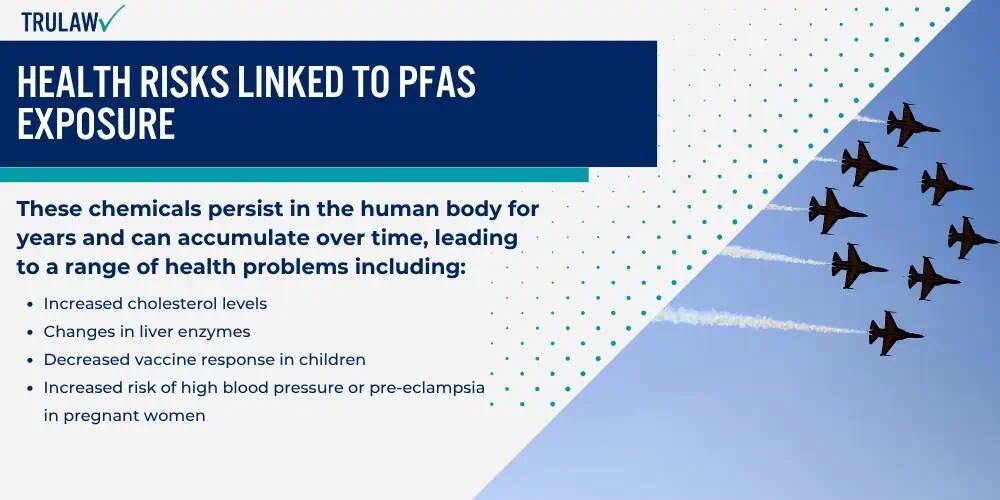The “forever chemicals” discovered at Barksdale Air Force Base have measured at catastrophically high levels – with testing in 2019 revealing onsite PFAS concentration of 1,100,000 parts per trillion, making it one of the most severely contaminated military installations in the nation.

Barksdale AFB is ranked 11th on the Environmental Working Group’s list of the top 100 most polluted military bases in the country.
The contamination levels detected are over 15,700 times higher than the EPA’s permissible limit of 70 parts per trillion.
PFAS exposure occurs primarily through drinking contaminated water, consuming contaminated food, or breathing air containing PFAS particles.
These chemicals persist in the human body for years and can accumulate over time, leading to a range of health problems including:
- Increased cholesterol levels
- Changes in liver enzymes
- Decreased vaccine response in children
- Increased risk of high blood pressure or pre-eclampsia in pregnant women
- Decreased birth weight
- Thyroid hormone disruption
- Weakened immune system function
- Other severe adverse effects
Research Associating PFAS Exposure to Cancer
Scientific research has established increasingly strong links between PFAS exposure and various forms of cancer.
These “forever chemicals” have been extensively studied by major research institutions worldwide, with compelling evidence demonstrating their carcinogenic potential.
The accumulation of these synthetic compounds in human tissue over time creates chronic exposure that appears to disrupt cellular processes, potentially leading to DNA damage and malignant cell growth.
As monitoring capabilities improve and longitudinal studies mature, researchers continue to strengthen the scientific understanding of how different PFAS compounds contribute to cancer development across various organ systems.
Scientific studies continue to provide evidence of the association between PFAS exposure and increased risk in developing the following types of cancer:
- Kidney Cancer: The National Cancer Institute has conducted the largest study of PFAS and kidney cancer to date, finding that higher concentrations of perfluorooctanoate (PFOA) in blood were associated with higher risk of kidney cancer confirmed by a systematic review and meta-analysis finding a staggering 18% increased risk of developing kidney cancer in association with PFAS exposure across 11 studies.
- Bladder Cancer: The American Cancer Society has linked PFAS exposure to various human cancers including bladder cancer, with a comprehensive epidemiological review examining multiple cancer sites noting that while evidence continues to develop, PFAS exposure increases risk factors that may contribute to bladder cancer development.
- Thyroid Cancer: Mount Sinai researchers identified that exposure to perfluorooctanesulfonic acid (n-PFOS) led to a 56% increased risk of thyroid cancer diagnosis supported by a clinical study further demonstrating that PFAS exposure is associated with elevated thyroid cancer risk and emphasizing the urgent need to reduce exposure through common routes like drinking water.
- Testicular Cancer: The National Cancer Institute found that elevated blood levels of perfluorooctanesulfonic acid (PFOS) were associated with higher risk of developing testicular cancer among U.S. Air Force servicemen with the Roswell Park Comprehensive Cancer Center confirming that testicular cancer has the strongest epidemiological evidence linking it directly to heightened PFAS exposure levels.
- Other Forms of Cancer: A University of Michigan study found that women with higher exposure to certain long-chained PFAS compounds had double the odds of a previous melanoma diagnosis while the National Academies of Sciences has documented possible associations between PFAS exposure and several other cancers including pancreatic, prostate, and breast cancer in their comprehensive federally-funded reports.
The contamination at Barksdale Air Force Base stems from decades of using aqueous film-forming foam (AFFF) for firefighting training and emergency response.
With more than 14,500 people living on the base and over 40,000 retired service members in the surrounding area, the potential impact on public health is substantial.
Studies of sediment and water surrounding historical fire training areas at Barksdale have confirmed widespread PFAS contamination, with multiple chemical variants detected at concerning levels.
Surrounding members of the community, Military veterans, and their families stationed at Barksdale Air Force Base may be eligible to seek compensation.
TruLaw is dedicated to providing support to those whose health has been compromised by these dangerous chemicals at no fault of their own.
Contact us using the chat on this page to receive an instant case evaluation that can determine if you qualify to join others in filing a PFAS Exposure Lawsuit today.
PFAS Contamination Across U.S. Military Bases
PFAS contamination extends well beyond Eaker Air Force Base, affecting hundreds of military installations across the United States.
The widespread use of AFFF firefighting foam has created a national crisis of contamination at bases operated by all branches of the armed forces.
Additional military installations that contain PFAS contamination include, but are not limited to:
- England Air Force Base
- Warren Air Force Base
- Sawyer Air Force Base
- Rock Air Force Base
- Altus Air Force Base
- Ellsworth Air Force Base
- Holloman Air Force Base
- Wurtsmith Air Force Base
- Vandenberg Air Force Base
- Grand Prairie Armed Forces
- Horsham Air Guard Station
- Tyndall Air Force Base
- Other Military and Air Force Bases
Testing at these facilities has revealed PFAS levels that frequently exceed safety standards by significant margins.
The Department of Defense faces growing pressure to expedite cleanup efforts, provide alternative water sources for affected communities, and take responsibility for decades of contamination.
Coordinated remediation plans now represent one of the largest environmental cleanup challenges in U.S. military history.





